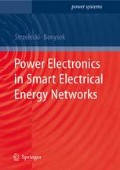Abstract
There is no doubt the near future will drive power generation towards DG and RES. Distributed generation units are not controlled and regulated by the power system operators. The power produced in DG units is optimized by the owner in order to maximize the profit, heat production or renewable sources utilization. This is done regardless of the power demand in the networks to which the sources are connected. If the DG utilization reaches more then dozen or so percent of the power production, the problem of power balancing will occur either in the local grid or in the whole system. The problem will become even bigger, if, as EU officially recommends, the power generation is based mainly on renewable sources, such as wind turbines or solar energy. Employment of renewable sources will cause not only decrease in the power quality, but also complications in balancing the power system.
Access this chapter
Tax calculation will be finalised at checkout
Purchases are for personal use only
Preview
Unable to display preview. Download preview PDF.
References
Walling RA, Miller NW, (2002) Distribution generation islanding – implications on power system dynamic performance. IEEE Conference Publications:92–96
Kim JE, Hwang JS, (2001) Islanding detection method of distributed generation units connected to power distribution system. Proceedings of the IEEE Summer Meeting:643–647
Willoughby R, (2001) Integration of distributed generation in a typical USA distribution system. IEE CIRED2001 Conference Publication, no.482:18–21
Brahma S, (2000) Effect of distributed generation on protective device coordination in distribution system. IEEE PES Summer Meeting:115–1119
Salles MBC, Freitas W, Morelato A, (2004) Comparative analysis between, SVC and DSTATCOM devices for improvement of induction generator stability. IEEE MELECON, Dubrovnik, Croatia
Gyugyi L, (1989) Solid-state control of electronic power in AC transmission systems. International Symposium on Electric Energy Converters in Power Systems, T-IP.4, Capri, Italy
Mcdermott T, Dugan RC, (2003) PQ reliability, and DG. IEEE Industrial Application Magazine:17–23
Simons G, Sethi P, Davis R, (2001) The role of renewable distributed generation in California's electricity system. IEEE Power Engineering Society Summer Meeting, vol.1:546–547
Kojovic L, (2002) Impact DG on voltage regulation. IEEE Power Engineering Society Summer Meeting, vol.1:97–102
Wang HF, Jazaeri M, Cao YJ, (2005) Operating M and control interaction analysis of unified power flow controllers. IEE Proceedings (Generation, Transmission, Distribution), vol.152, no.2:264–270
Usta O, Redfem M, (2000) Protection of dispersed storage and generation units against islanding. IEEE PES Summer Meeting 2000:976–979
Barker P, (2000) Determining the impact of distributed generation on power systems. Part 1: radial distribution systems. IEEE:1645-1656
Mathur RM, Varma KR, (2002) Thyristor – based FACTS controllers for electrical transmission systems. IEEE Press, New York
Gyugyi L, (1992) Unified power flow control concept for flexible AC transmission systems. IEE Proceedings, part-C, vol.139, no.4
Sannino A, Svensson J, Larsson T, (2003) Power electronic solution to power quality problems. Electric Power Systems Research, vol.66:71–82
Gyugyi L, Hingorani NG, (1990) Advance static VAR compensator using gate-tranoff thyristor for utility applications. CIGRE, no.23-203
Hingorani NG, Gyugyi L, (2000) Understanding FACTS: concepts and technology for flexible AC transmission systems. Piscataway, IEEE Press
Marks M, (2000) Distributed generation: CEQA review and permit streamlining. California Energy Commission, report 700-00-019
IEEE Standard 1547-2004, (2004) 1547 IEEE standard for interconnecting distributed resources with electric power systems. Institute of Electrical and Electronics Engineers, Piscataway, New Jersey
Bhowmik A, Maitra A, Schatz SM, (2003) Determination of allowable penetration levels of distributed generation resources based on harmonic limit considerations. IEEE Transactions on Power Delivery, vol.18, no.2:619–624
Al-Mawsawi SA, (2003) Comparing and evaluating the voltage regulation of a UPFC and STATCOM. Electric Power and Energy System, vol.257:735–740
Rashid MH, (2003) Flexible AC transmission. Chapter13: power electronics circuit devices and applications. Pearson Prentice Hall, third edition
Lasseter R, (2002) Microgrids. Proceedings of the Power Engineering Society Winter Meeting, vol.1:27–31
Ackermann T, Andersson G, Soder L, (2001) Distributed generation: a definition. Electric Power System Research, vol.57:195–204
Friedman NR, (2002) Distributed energy resources interconnection systems: technology review and research needs. National Renewable Energy Laboratory, report SR-560-32459
Dugan RC, Price SK, (2002) Issues for distributed generation in the US. Power Engineering Society Winter Meeting, vol.1:121–126
Rifaat RM, (1995) Critical considerations for utility/cogeneration inter-tie protection scheme configuration. IEEE Transactions on Industry Applications, vol.31, no.5:973–977
Daly PA, Morrison J, (2001) Understanding the potential benefits of distributed generation on power delivery systems. Rural Electric Power Conference:A211–A213
Author information
Authors and Affiliations
Editor information
Editors and Affiliations
Rights and permissions
Copyright information
© 2008 Springer London
About this chapter
Cite this chapter
Biczel, P. (2008). Energy Storage Systems. In: Strzelecki, R., Benysek, G. (eds) Power Electronics in Smart Electrical Energy Networks. Power Systems. Springer, London. https://doi.org/10.1007/978-1-84800-318-7_9
Download citation
DOI: https://doi.org/10.1007/978-1-84800-318-7_9
Publisher Name: Springer, London
Print ISBN: 978-1-84800-317-0
Online ISBN: 978-1-84800-318-7
eBook Packages: EngineeringEngineering (R0)

